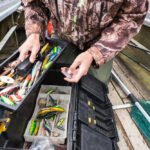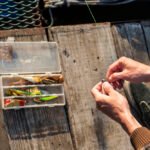How to Use a Fishing Lure: A Beginner’s Guide
Are you frustrated that the fish aren’t biting? It would help if you had an attractive fishing lure. Welcome to the beginner’s guide to bait fish with lures. Don’t worry; lure fishing is straightforward. I’ll teach you everything you need to know about using the best lures to catch huge fish species.
Quick Guide: How to Pick a Fishing Lure

- Understand the depth differences between lures: surface, sub-surface and deep.
- Use surface lures in the spring, deep lures in the summer, and sub-surface lures in the fall.
- Choose the right size and type of lure according to the fish you are trying to catch.
- Use weed guards when fishing in water with thick weeds and brush.
- Consider the color of the lure. Light-colored lures are excellent in clear water, and dark, fluorescent lures work best in dark, murky waters
- Match your lures to the types of animals that fish naturally eat in that location.
- Understanding the uses of various lures will make you a more effective angler: Topwater, Diving plug, Vibrating, Spinners, Flies, Spoons, Soft plastic lures, Jigs, Wirebaits, and more.
Quick Guide: How to Attach a Lure

- Attach the lure to the fishing rod with a knot, and tie the lure directly to the line when using jigs.
- You attach the lure at the end of the fishing line.
- A few reliable knots you can use are the San Diego jam, the six-turn Yucatan knot, and the Rapala knot.
- Using a snap clasp or swivel is a practical and quick way to change the lure. Experienced fishermen often change to see which lure makes the fish bite.
- Using a snap-swivel can allow the lure to twist and turn without twisting the line. Using a swivel is advantageous as the line doesn’t get tangled when you retrieve it. It also allows a spinning lure to move naturally through the water.
Quick Guide: How to Fish with a Lure

- Attach the lure to the fishing rod, and cast it into the water.
- Pick a suitable lure for your target fish species and scenario.
- Remember that warmer water makes fish more energetic, whereas colder water makes them slower. So move the lure slower in cold water and faster in warm water.
- If you are targeting northern pikes and muskies, pause before retrieving.
- If you are targeting twitch or walleyes, wait before retrieving. You can also use smaller lures, such as jigs, and troll them at the bottom.
- You should test many lure types for your fishing scenario to see which makes the fish bite.
- Keep many fishing lures in your tackle box.
What is a Fishing Lure?
Fishing lures are artificial bait made by humans with one or more hooks attached to them. The objective of a lure is to mimic the real thing, a small tasty fish, worm, fly, or other appealing meal that fish are hungry for. Once the fish bites the lure, it gets hooked, and the angler reels in their new catch. The lures come in all shapes, sizes, weights, and colors for different use cases. Some are specific for fly fishing, others for trolling.
Choosing the Right Lure for Different Types of Fish (Beginner Guide)

How do you know which lure to choose when you are going fishing? Let’s look at the different types of lures and what they are suitable for.
Hard lures
Hard fishing lures are made from plastic, wood, metal, or rigid materials. They are almost indestructible and will last you a long time. They come in various colors, weights, sizes, patterns, and shapes. They often mimic a live fish, but their movements through water can seem rigid and stiff and may not be as smooth as a soft lure.
Spinner lures
A spinner lure is a small metal lure with a thin body with a broader metal plate loosely hanging from the top of it, and anglers mostly use it in freshwater fishing. When the lure is retrieved and moves through the water, or when placed in a stream of water against the current, the metal plate spins around the body, making a very noticeable, flashing, vibrating, and alluring motion for predator fish. Spinning lures are often bright and colorful and are great for mimicking live bait swimming in the water. The good thing about a spinning lure is that it’s almost impossible for fish to ignore its apparent motions. Still, they are limited to specific fishing scenarios and may not be effective in others.
Soft lures
Soft plastic lures are made from plastic and are better at mimicking the natural movements of soft bait in the water. Depending on the bait they resemble, they can also come in various vibrant colors and patterns. They are practical, versatile, and effective in catching fish but are not nearly as durable as hard lures.
Jig lures
Jig lures are longer and heavier lures of various sizes and shapes with a specific design that makes them move in a particular motion through the water. Depending on its design and shape, it could back slide, spiral down, wobble, fall in a leaf-like motion, or have an irregular movement. The good thing about jig lures is that they are good at mimicking alluring movements, and you can use them for both casting and fishing vertically, but they may be less effective than other lures in streams or certain water conditions.
Spoon lures
Spoon lures are made of metal and resemble a spoon in its shape. It is often slightly wavy, mimicking a fish’s movement when pulled through the water. They are silver, gold, or any bright color and shiny to reflect light and make it more noticeable. You can use a spoon lure for trolling or casting. They are versatile and excellent for mimicking injured baitfish but may not be as effective as jigs for fishing vertically.
How to Fish with Lures from Shore (Surf Fishing)

You must pick a lure suitable for your chosen location when fishing from shore, surf fishing, or beach fishing. If there are seaweed, rocks, and debris in the water, there is more risk that the lure gets entangled or hooked to something, and you can’t get it loose, compared to a sandy, muddy or smooth sea bottom. However, fish often congregate near structures in the water and use logs, rocks, and weeds as hiding places or hunt prey.
When you cast from the shoreline, especially from a beach, you need to use a longer fishing pole, so you have enough casting distance to reach far into the sea. The tide, current, and waves can significantly affect casting distance and where the fish are hiding. Also, there are specific lures that work better for seashore fishing. Advanced fishermen will use a variety of tricks, such as drifting baits and bottom bait, and attach sinkers and floaters to their line to precisely place their lure in the location they believe the fish is swimming and can have more than one lure on the line and thereby target several species of fish on a single line.
For surf fishing, a fisherman can use various equipment to enhance the line and lure by using different setups, for example, a sliding sinker rig or Carolina rig, a spreader rig or chicken rig, a 3-way drop rig, or a knocker rig. These setups use various sinkers, breakaway lines connected to a three-way swivel, or an egg sinker with beads and a two-way swivel. They combine a light mono or fluorocarbon line with a heavier main line.
Frequently Asked Questions
What kind of fishing lure should I use?

It depends on the type of fish you are targeting and your fishing location. For example, a plastic worm or spinner bait may be effective if you’re fishing for bass in a freshwater lake. If you’re fishing for salmon in a river, a spoon or a hoochie may be more suitable. In saltwater, a jig or a soft plastic lure can catch species such as snapper or sea bass. The location and conditions should also be considered, such as using a topwater lure early in the morning or a subsurface lure in murky water.
How do I know what lures to use for different fish?

You can ask local fishermen in your area what lure works for the fish you are targeting, as the answer will differ depending on the conditions. If you are fishing for bass, try plastic worms, spinnerbaits, and crankbaits. If you are targeting trout, try spinners, spoons, and flies. To catch snappers, try jigs, soft plastic lures, or topwater plugs for shore fishing.
How do I rig a fishing lure?

Generally, you need to attach the lure to your fishing line either directly by tying a knot on the end of the line or through a connector clasp or swivel tied to the line. You can rig a fishing lure by threading the line through the top ring or nose and then tie a Palomar knot or power knot to secure it to the line.
Are there specific lures for freshwater or saltwater fishing?

Yes. Spinners, flies, worms, and crankbaits are often used for freshwater fishing to catch bass, pike, or panfish. Saltwater lures are often jig lures, soft and hard lures, and target snappers, tarpon, and sea bass. Depending on how alluring it is to the fish you are targeting, you can use many lures in freshwater or saltwater.
Are there specific lures for different types of fish?

Yes. Different types of fish live in different habitats, and their behavior and diet may vary, so you should use the best lure type to catch a fish by mimicking its favorite natural bait. For example, basses are attracted to worms, sinners, and crankbaits. Trouts and salmon find spinners, flies, and spoons alluring. Tuna will prey on various lures, and jigs and minnow baits are effective for fishing walleyes.
Which lure color is the best for fishing?
Many people have great success with bright colors such as green, red, and orange, but you should use a color that resembles the fish’s food and is unignorable in the water.
What is the best lure for predator fish?
Keep in mind that predators chase after lures because of their movement more than their color, so use a lure that mimics the motion of the live bait the fish tend to hunt.
Do I have to use a lure or bait, or can I fish with a hook?
A fish hook doesn’t look like fish food, and most fish won’t be interested or try to hunt a hook by itself. You will be much more effective in your fishing efforts if you add live bait or use a lure to entice the fish.

